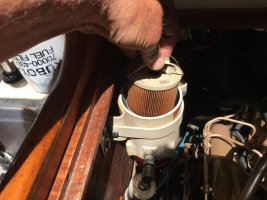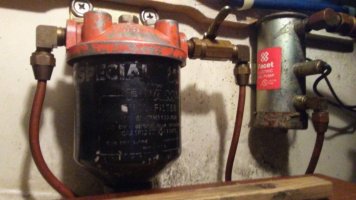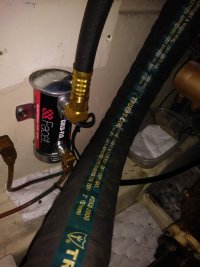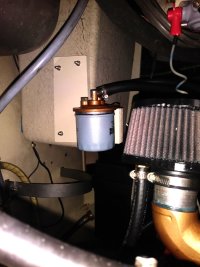Pete the Cat
Member III
This has probably been covered somewhere, but I could not find it. I have been the emergency diesel mechanic for my dock and sometimes for others in my cruising years. I recently changed the fuel filters and thought it might be helpful to remind folks of some fairly simple steps make the process easier. Here are some suggestions earned from the mechanics school of failed efforts:
1. Do are really need to change the filters? I note that some folks and some yards suggest changing filters annually no matter what. I would respectfully disagree. Clean fuel is really important but if your primary Racor is showing dirt or water annually, I suggest you have a problem in your tank that needs attention--and soon--- keeping your tank clean is possible and fairly easy--a dirty tank could overwhelm your filters no matter how recently you have changed them--(learned on a deliverly trip across the Bay of Fundy--changing filters in a seaway is no fun--the owner had fortunately a case of them on board-that should have forewarned me). I recall the Yanmar service manual (there is a reason new engines are sold with Racor systems as part of the installation) says that you should change filters every 300 hours or when the engine stops (!). I have a Tartan 37 I have sailed for 32 years (about 100 hours a year--except for some long cruises) and change them every 3 years or if I see any gunk at all in the Racor drain. I keep my tank as full as possible, use biocide, change the fill O ring regularly, and check the tank for water and dirt annually--and I attribute my not having problems with my own boats to these efforts.
2. Before you start changing filters, be sure to turn off the fuel line between the filter and the tank. If you do not, the fuel will run back into the tank and you will create air in the line that can create a need for excessive bleeding efforts. Generally, I do not have to bleed anything with Yanmar or Universal/Westerbeke if I remember to turn off the feed line before starting.
3. Change the primary filter first and do the secondary at a later time if you can. The reason is that you might introduce dirt and excessive air with the changing of the filters and the secondary can catch this. I know there is controversy about this, but generally a 10 micron Racor (24T) is considered by Yanmar and my mechanics as a good primary mesh. Using a 2 micron Racor can strain the pumps over time, and your secondary filter is generally in the 2-5 micron range and will keep your injector pump clean.
4. Clean the Racor bowl and fill the filter with clean fuel to the brim before reinstalling. This will save bleeding. Be as clean as possible, but understand that if you are changing the primary and secondary at different times, the secondary will prevent dirt from getting into your injector pump.
5. Then fill and change the secondary filter at a later date after the engine has run at least a half hour or longer. The idea is to ensure you have not introduced dirt or a lot of air into the system. My experience is that there is no need to bleed in any engine I have worked on when using this two step process. The yard mechanics obviously cannot take the time to do it this way and you should know how to bleed your engine in an emergency. I hate bleeding if it can be avoided.
6. Bleeding problems: My experience is that if the engine will start but runs very badly, it has air in one of the injector lines. Turning bleeding screws on the pump will not solve this problem. I generally let the engine run badly for a few minutes and it may straighten out on its own. Otherwise, there is air in the line between the injector pump and an injector. You can loosen the screw on the top of each injector while the engine is running (badly) to look for bubbles and the engine will start running right or get worse. If you see bubbles of air you found the problem. If the engine gets worse or stops--you have not found the right injector line yet, but it ain't this one.
Many of the Yanmars are self bleeding--whatever that means. I really think that they are much the same as any other engine, they just guide you through this process and tiresome bleeding is rarely needed if you are careful. Except when I have had to replace an injector pump or a whole system, I do not recall a time when I actually had to aggressively bleed a small diesel. I am not a professional mechanic, but have rebuilt and installed a few engines and maintained several through years of cruising, so I will accept any correction from anyone with more professional background. I just thought I would pass this along FWIW. I would like to have known this about 50 years ago. I have lost a lot of skin and blood reaching for those bleeding screws. And I think most of that could have been avoided.
1. Do are really need to change the filters? I note that some folks and some yards suggest changing filters annually no matter what. I would respectfully disagree. Clean fuel is really important but if your primary Racor is showing dirt or water annually, I suggest you have a problem in your tank that needs attention--and soon--- keeping your tank clean is possible and fairly easy--a dirty tank could overwhelm your filters no matter how recently you have changed them--(learned on a deliverly trip across the Bay of Fundy--changing filters in a seaway is no fun--the owner had fortunately a case of them on board-that should have forewarned me). I recall the Yanmar service manual (there is a reason new engines are sold with Racor systems as part of the installation) says that you should change filters every 300 hours or when the engine stops (!). I have a Tartan 37 I have sailed for 32 years (about 100 hours a year--except for some long cruises) and change them every 3 years or if I see any gunk at all in the Racor drain. I keep my tank as full as possible, use biocide, change the fill O ring regularly, and check the tank for water and dirt annually--and I attribute my not having problems with my own boats to these efforts.
2. Before you start changing filters, be sure to turn off the fuel line between the filter and the tank. If you do not, the fuel will run back into the tank and you will create air in the line that can create a need for excessive bleeding efforts. Generally, I do not have to bleed anything with Yanmar or Universal/Westerbeke if I remember to turn off the feed line before starting.
3. Change the primary filter first and do the secondary at a later time if you can. The reason is that you might introduce dirt and excessive air with the changing of the filters and the secondary can catch this. I know there is controversy about this, but generally a 10 micron Racor (24T) is considered by Yanmar and my mechanics as a good primary mesh. Using a 2 micron Racor can strain the pumps over time, and your secondary filter is generally in the 2-5 micron range and will keep your injector pump clean.
4. Clean the Racor bowl and fill the filter with clean fuel to the brim before reinstalling. This will save bleeding. Be as clean as possible, but understand that if you are changing the primary and secondary at different times, the secondary will prevent dirt from getting into your injector pump.
5. Then fill and change the secondary filter at a later date after the engine has run at least a half hour or longer. The idea is to ensure you have not introduced dirt or a lot of air into the system. My experience is that there is no need to bleed in any engine I have worked on when using this two step process. The yard mechanics obviously cannot take the time to do it this way and you should know how to bleed your engine in an emergency. I hate bleeding if it can be avoided.
6. Bleeding problems: My experience is that if the engine will start but runs very badly, it has air in one of the injector lines. Turning bleeding screws on the pump will not solve this problem. I generally let the engine run badly for a few minutes and it may straighten out on its own. Otherwise, there is air in the line between the injector pump and an injector. You can loosen the screw on the top of each injector while the engine is running (badly) to look for bubbles and the engine will start running right or get worse. If you see bubbles of air you found the problem. If the engine gets worse or stops--you have not found the right injector line yet, but it ain't this one.
Many of the Yanmars are self bleeding--whatever that means. I really think that they are much the same as any other engine, they just guide you through this process and tiresome bleeding is rarely needed if you are careful. Except when I have had to replace an injector pump or a whole system, I do not recall a time when I actually had to aggressively bleed a small diesel. I am not a professional mechanic, but have rebuilt and installed a few engines and maintained several through years of cruising, so I will accept any correction from anyone with more professional background. I just thought I would pass this along FWIW. I would like to have known this about 50 years ago. I have lost a lot of skin and blood reaching for those bleeding screws. And I think most of that could have been avoided.






